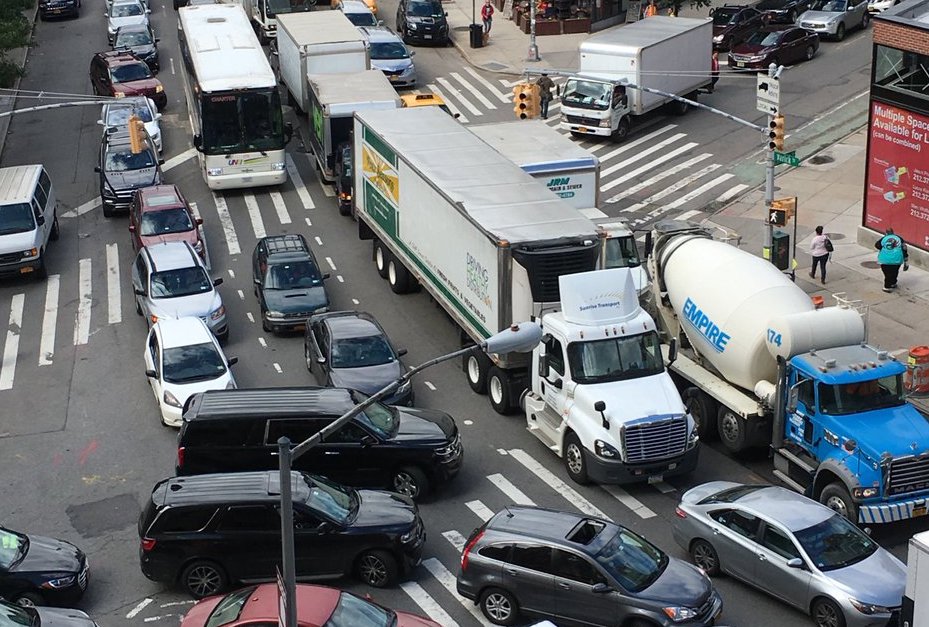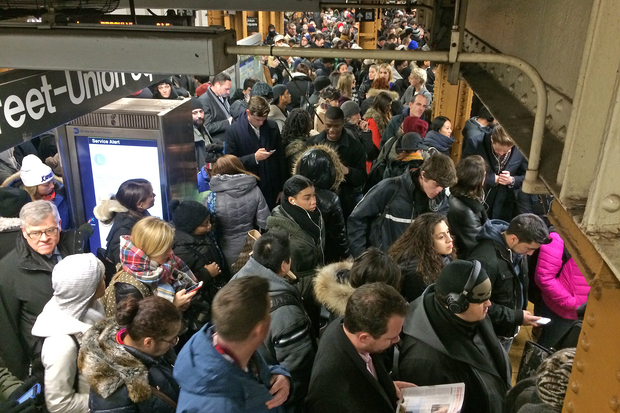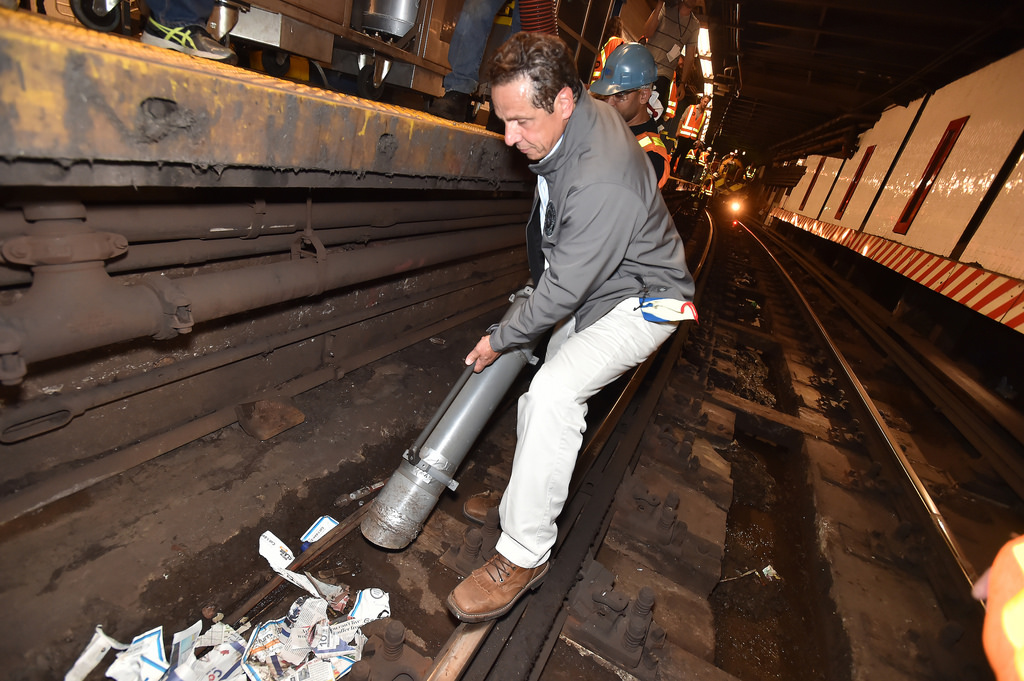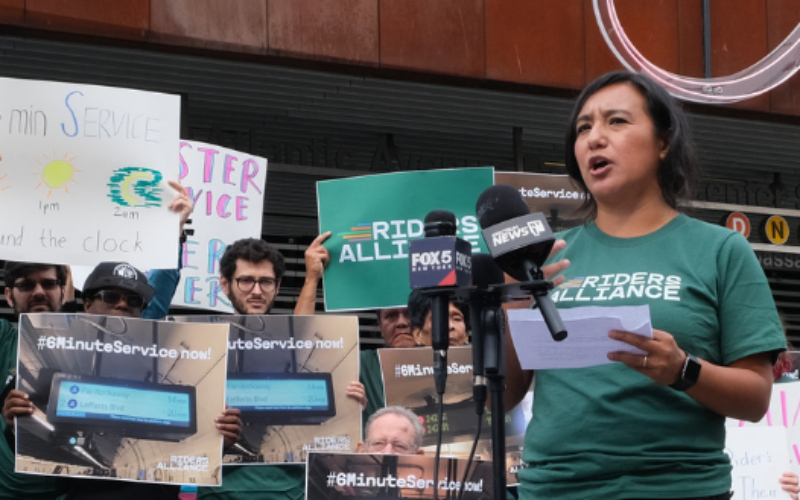

The New York City boomtown of 2015 or 2005 could never have been built above the decrepit subway system of 1985. And once again, transit in New York is in need of an epic save. New York won’t continue to prosper unless state and city leaders get to work to find the resources for Fast Forward, NYC Transit President Andy Byford’s sweeping plan to modernize New York City’s transit system. If implemented, the plan would run more trains on crowded lines, install elevators at hundreds of inaccessible stations, replace aging subway cars and reorganize the city’s vast bus network.
For transit advocates, congestion pricing presents the most logical untapped funding stream for Fast Forward, even if more revenue than congestion pricing can reasonably raise will ultimately be needed. Not only would a charge on car trips into NYC’s central business district provide the transit system with a large, stable source of revenue, it would also clear space on city streets, rescuing the slowest parts of the bus system from its tailspin of declining speeds, reliability and ridership.
The discomfort with which the political class views congestion pricing is palpable, and to some degree masks whether a real political effort to save New York’s transit system is gathering steam.
What will it look like when or if New York seriously gears up to fix transit?
The state legislature will start addressing the issue like a responsible party who must approve funding
The subway and the NY State-chartered public authority that runs it has been crashing and burning — or at least smoking — since the summer of 2017, but neither of Albany’s legislative houses has even convened an oversight hearing on what is going on. Democratic Conference Chair Michael Gianaris of Queens has provided a leadership voice on the issue from the State Senate, but the NY State Assembly has been a truly empty chair at the transit table. State Assembly Speaker Carl Heastie of the Bronx has remained Sphinx-like throughout the crisis. Now that the Senate will be controlled by Democrats and could be poised to show up downstate Assemblymembers, State Assembly Corporations Committee Chair Amy Paulin has pledged hearings in January. A few individual Assemblymembers are beginning to talk about the need for revenue, but it won’t matter unless Heastie shows determination to make a real fix happen at the state budget negotiating table.
The MTA will tell stories of recent successes, and let New Yorkers see themselves in plans to rebuild
The MTA needs to do a better job talking about how it is doing things differently, and conveying the benefits of Fast Forward in terms riders can understand. New York City Transit’s Fast Forward pitch has focused on equipment––how many subway cars the system will get, how many lines might receive new signals. But everyday riders don’t care about subway signals. They want to know how their commutes from Ozone Park will improve. The pitch we’ve heard at several town hall meetings has lacked key specifics about what service improvements will be made to which neighborhoods in the city. To make a more powerful case to the public, the MTA needs to translate technical improvements into terms a rider or politician can see herself in, like how much time she’ll get back in her day on her commute to work.
City/MTA messaging was clearer during the 2007-2008 fight over congestion pricing. To help sell the proposal to riders, the MTA promised multiple new bus routes, including 8 express routes into Manhattan. In promotional materials, it spelled out precisely what subway capacity improvements riders on the 1 train to the Bronx, the C train to Brooklyn, and the E and F lines to Queens could expect. Mayor Bloomberg and MTA leaders went to neighborhoods across the city to sell the plan. They even travelled to the Northeast Bronx to “cut the ribbon” on a new express bus route from Throgs Neck to Lower Manhattan that would exist only if congestion pricing was approved by the State Legislature.
More specifics like these would surely help today. So would more stories about reform starting to take hold within the MTA. It’s fair to question the logic of pumping billions of new dollars into an agency hasn’t used it well in the past, so anything that says “this is not the old MTA” may be a key to transit funding victory in Albany in 2019. It is incumbent on the MTA to detail what steps it is taking to rein in exorbitant costs, archaic procurement procedures and to start telling early Byford success stories.
City government will get out of the way or actually help
Mayor de Blasio has vacillated between outright hostility and begrudging acceptance of congestion pricing. He’s amplified the false narrative that it is inequitable. And yet, he’s displayed an utter lack of urgency around bus lane expansion or enforcement, even though bus riders are generally lower-income than the city as a whole. This matters immensely because congestion pricing won’t work as well without attractive bus service.
If de Blasio doesn’t speak up on behalf of congestion pricing and bus improvements, we expect Council Speaker Corey Johnson will. Johnson has become the de facto leader of New York City on major transportation issues. He was decisive in bringing city government to back and enact Fare Fares and the Uber cap, and worked around the state legislature to save speed cameras at school zones. The Speaker can serve as a unifying, high-level city government voice explaining how the policy will benefit transit riders and drivers alike.
Governo Cuomo will exercise his electoral mandate to knock heads, twist arms and make all parties get behind an historic plan to rebuild the transit system

If anyone should be out stumping at the sites of future transit improvements, it’s Governor Cuomo. The subway has deteriorated into physical and financial crisis on his two-term watch. The qualities the Cuomo executive leadership image is built on — a leading voice, pragmatic policy making and blunt exercise of power where needed — are exactly what NY’s political system requires now to pull off a huge history-changing turnaround. But Cuomo sowed confusion again yesterday, claiming at once that he was not in charge of the MTA but also suggesting fixing it is one of his big priorities.
If New York City manages to pull off congestion pricing, the policy impact will reverberate around the world. New York’s leaders will make history. Everyone and their cousin will be present themselves as architects of amazing progress and innovation. But the hard part is now. Exercising leadership, moving through all the reasons why not, and lining up the political scenario for approval and implementation. Is New York up to the task?
 On the Brink: Will WMATA’s Progress Be Erased by 2024?
On the Brink: Will WMATA’s Progress Be Erased by 2024?
The experience of being a WMATA rider has substantially improved over the last 18 months, thanks to changes the agency has made like adding off-peak service and simplifying fares. Things are about to get even better with the launch of all-door boarding later this fall, overnight bus service on some lines starting in December, and an ambitious plan to redesign the Metrobus network. But all of this could go away by July 1, 2024.
Read More Built to Win: Riders Alliance Campaign Secures Funding for More Frequent Subway Service
Built to Win: Riders Alliance Campaign Secures Funding for More Frequent Subway Service
Thanks to Riders' Alliance successful #6MinuteService campaign, New York City subway riders will enjoy more frequent service on nights and weekends, starting this summer. In this post, we chronicle the group's winning strategies and tactics.
Read More